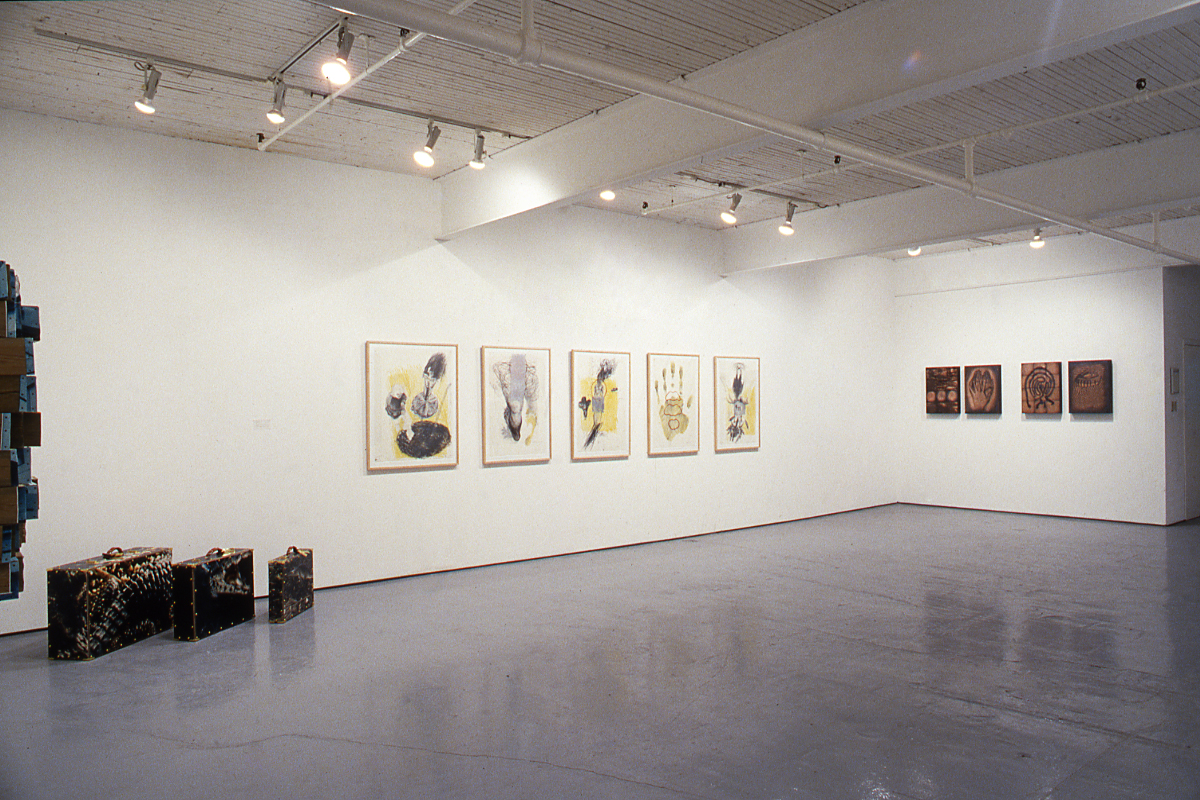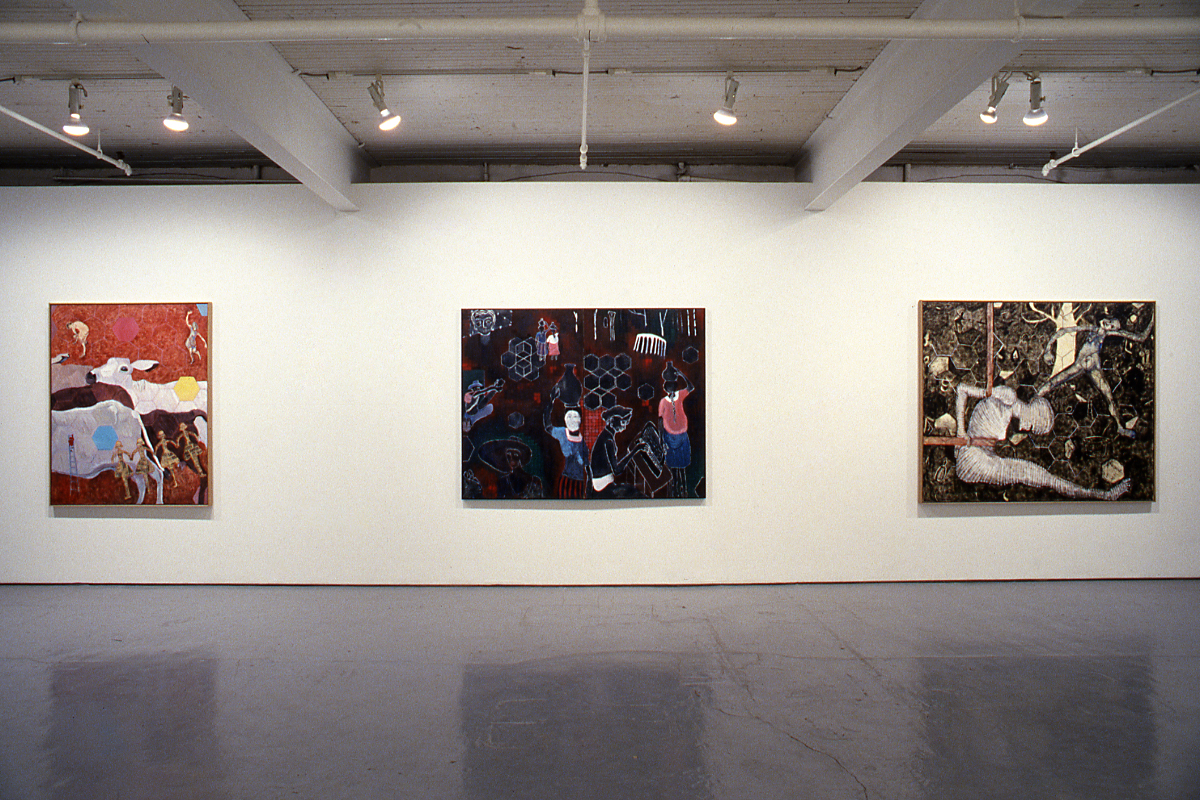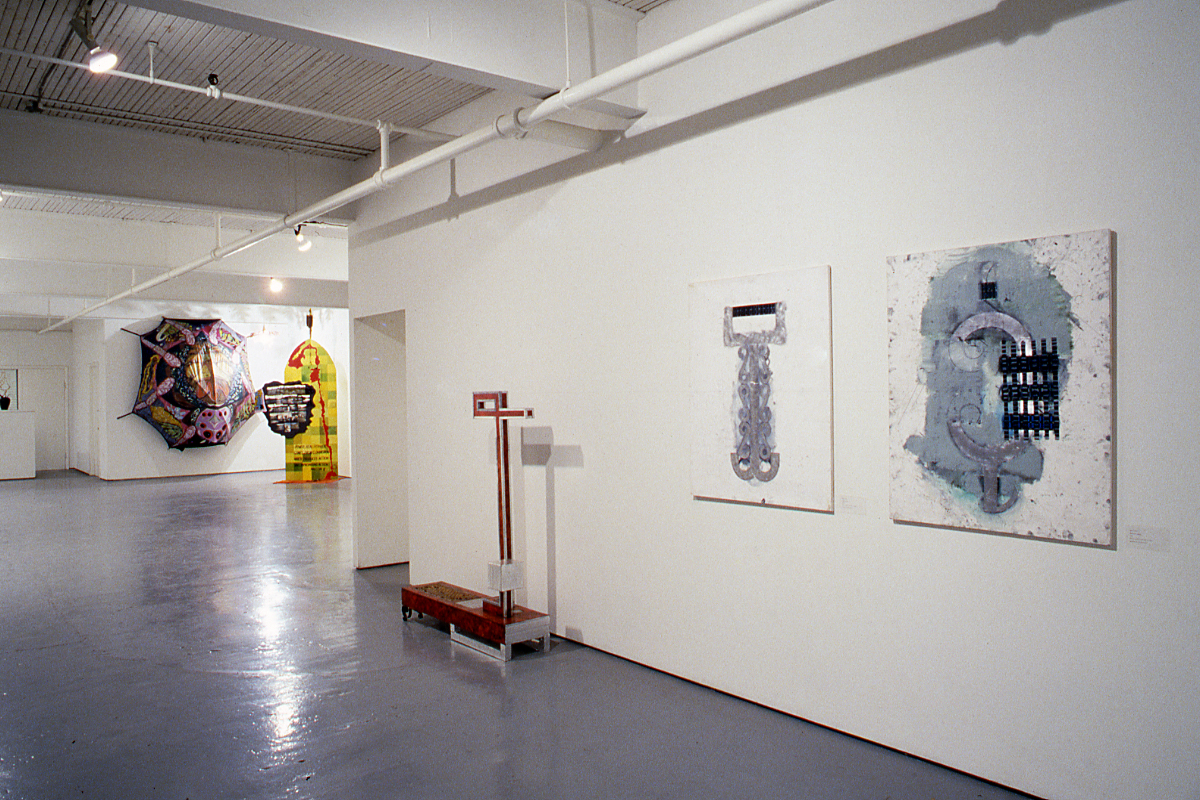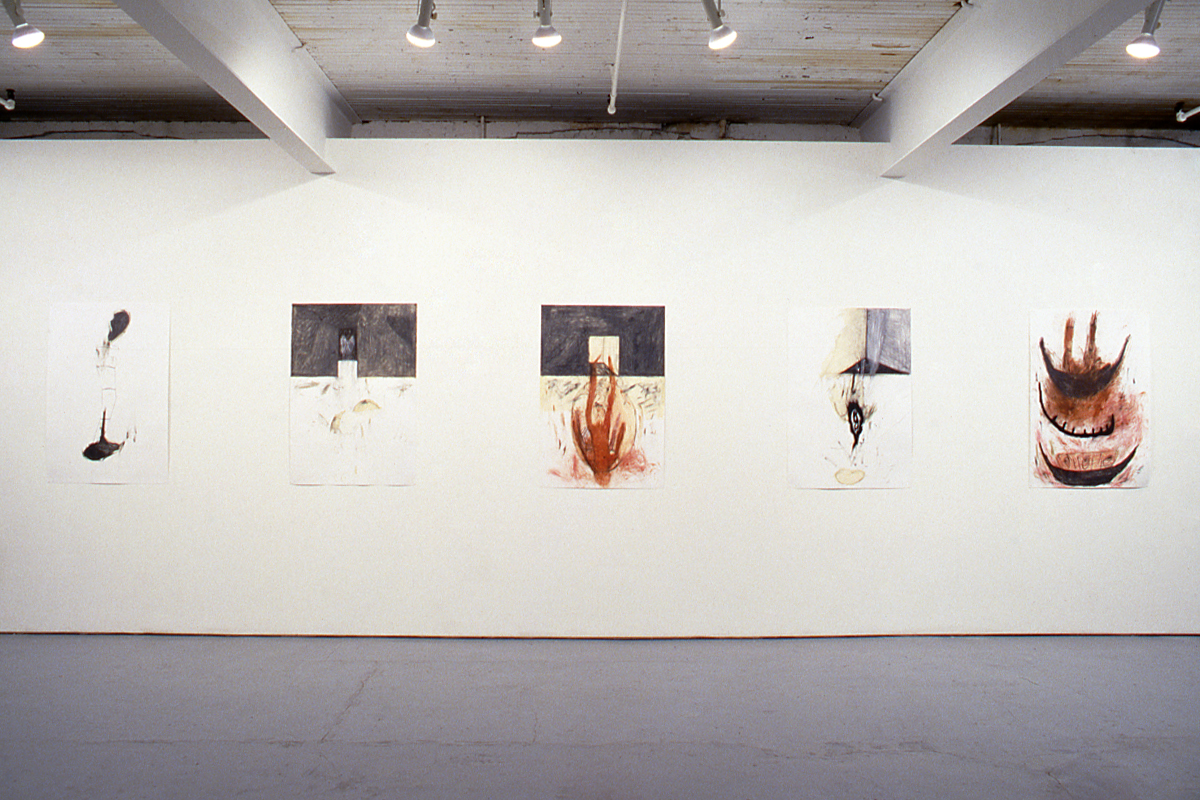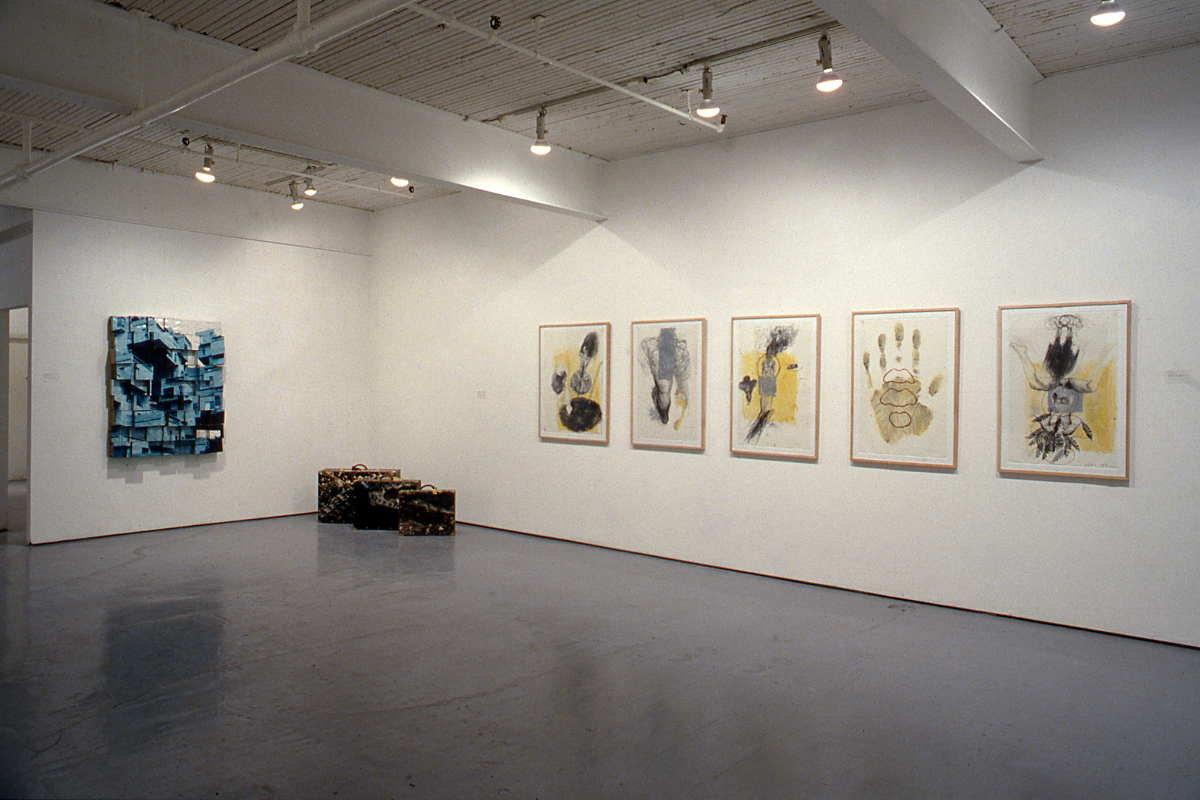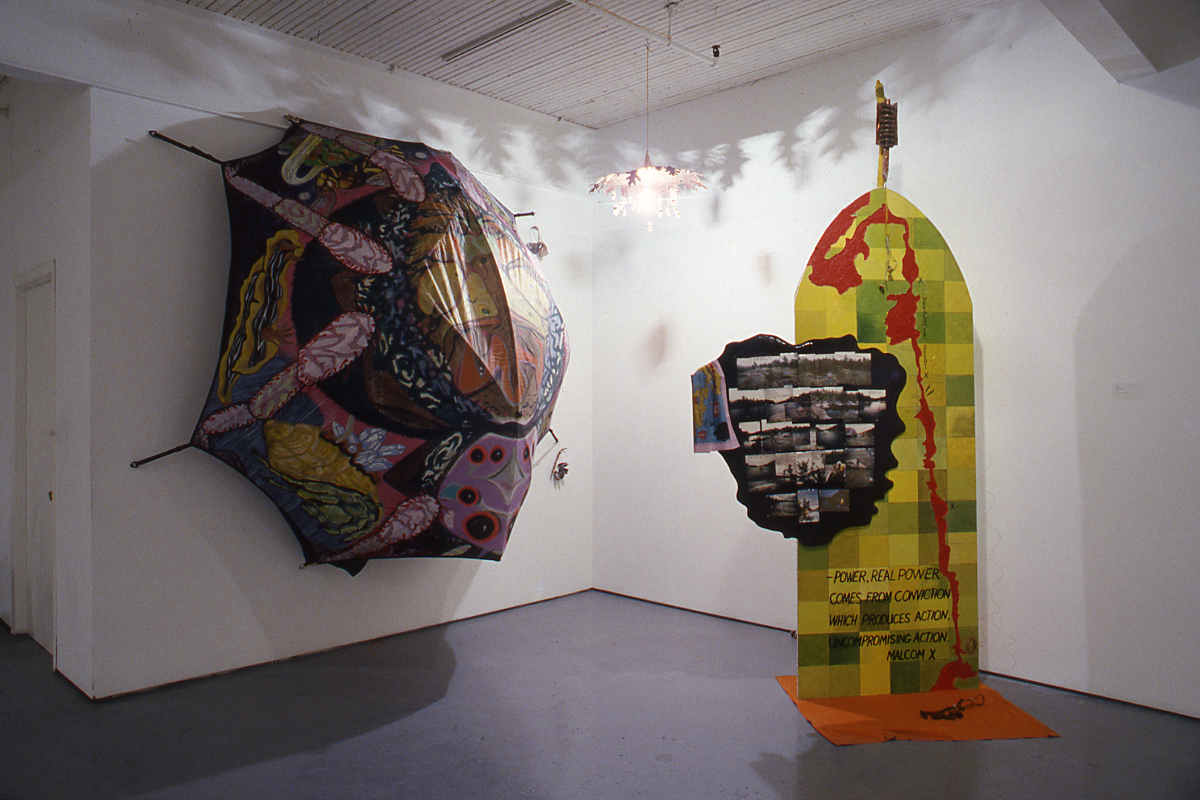East & West Galleries:
Belief Structure brings paintings, drawings and sculptural installation by nine local artists: Stephen Andrews, Alan Belcher, Carlo Cesta, Nadine Chan, Shelagh Keeley, Carol Martyn and the collaborative group FASTWURMS (Napoleon Brousseau, Kim Kozzi and Dai Skuse). Toronto painter Andy Fabo has curated this exhibition in response to what he sees as a large segment of artwork which has not been fully examined in Toronto, work he describes as stemming from the individual rather than from an aesthetic discourse.
In the interview accompanying the exhibition, Fabo addresses the contemporary notion of the 'death of originality', 'the death of authorship', a concept stemming from the critical thought of 20th century French theorists. Working against this prevailing current, the artists in Belief Structure are concerned with morality, the human body, and subjective interpretation, offering a constructively critical and positive outlook. Belief Structure opens at Mercer Union Tuesday, May 31 at 8 pm, and continues through Saturday June 25th.
BELIEF STRUCTURE
an Interview by LINDA GENEREUX, published by Mercer Union
Toronto painter Andy Fabo has drawn together the work of six local artists (Shelagh Keeley, currently living in New York but exhibits regularly In Toronto) and the artist group FASTWURMS (Kim Kozzi, Dai Skuse and Napoleon Brousseau) for this exhibition. Fabo has curated this show in response to what he sees as a large segment of work which has not been fully examined In Toronto. It brings together paintings, drawings, and sculptural installation which endorse subjective interpretation, morality, and an identification with the physical body. In this interview, Fabo sets his frame of reference against the notion of the death of originality. Belief Structure posits the alternative, focusing on art which stems from the individual rather than a detached aesthetic discourse. Through this conversation, Fabo discusses the positive, regenerative outlook that informs the work.
Linda Genereux: Why did you call this exhibition Belief Structure ?
Andy Fabo: I liked the title Belief Structure because it is an expression that evokes both vagueness and definition. As an oxymoron, 'structure' makes us think of the tangible, tectonic, and defined, whereas 'belief' suggests the abstract, amorphous and changeable. As the curator, I wish to explore the relationship between these two dichotomies.
LG: Andy, when we were discussing this exhibition in generalities, you brought up a number of times the word 'closure'. Can you explain its meaning?
AF: The dictionary meaning is the act of "closing and shutting, to end, finish or conclude". 'Closure' has been an impulse in western philosophy since the Romantic era, and this has carried into the specialized field of aesthetics. Probably the first definitive act of closure was Duchamp's sculpture The Fountain (1917), a urinal (Readymade) signed "R. Mutt". It's only a re-contextualization and there's no synthesis in this piece. It was an endgame, attempting to shut the book on art.
Another example of the sort of closure I'm talking about were those iconoclastic pronouncements of the nineteenth and twentieth centuries, such as 'the novel is dead', 'art is dead'. While intellectuals were saying this, others were producing art and novels that seemed relevant to a large number of people, and that were innovative. There are still new things being introduced in art today because life and the context surrounding the production of art is always changing.
LG: Belief in the death of originality is echoed in contemporary discourse. What position are you taking in response to this?
AF: Basically I'm positing this exhibition as a grouping of art that is generative: art that is in a constant state of regeneration. To clarify this in art historical terms, I counter Duchamp's Fountain with Meret Oppenheim's Fur-Covered Cup, Saucer and Spoon (1936). She didn't just take the teacup, put it in the gallery, and rely on context to make it art. Instead she relied on the synthesis of applying fur to the teacup, creating more than one new meaning around the piece. A proliferation of erotic and personal connotations occur. This is the regeneration that I refer to.
Today the onus is on the artist to imbue the piece with his/her own ethical code, yet I think that a lot of work that deals with closure does not do that. It is usually ethically neutral work. It leaves the art dismantled and doesn't take the responsibility of rearranging the pieces.
LG: Then you are suggesting that the work chosen for this exhibition is permeated with a personal or moral ethic?
AF: There is a positive moralism in all of the work. In Alan Belcher's assemblages it is understated, whereas with other artists such as Carol Martyn and Stephen Andrews it is very played up. A lot of the moralism is an analysis of 'the self' and 'the subject' in relationship to 'the object'. There has been a history of this exploration in Toronto: Philip Monk has done that in Subjects and Pictures, and the last show of Bruce Grenville's Active Surplus also did that. They both operated in two different ways. Monk is incredibly Cartesian; he really divides between the subject and the object, and then devalues the subject but wishes to retain it in privileged circumstances. Bruce Grenville almost seems to annihilate the subject; everything becomes Object, even language. I think that is really a disputable point.
I'm trying to find the middle between rational objectivity and unmediated subjectivity. Art of the insane seems to be making a comeback. Art & Text did an issue on l'Art Brut for example. I don't think that work between those two polarities has to make its own ethical decisions. Work that's totally objective can very easily feel removed in its detached criticality and not acknowledge its own complicitness, shifting the responsibility onto someone else. That gap created by the subject-object dichotomy allows it an escape hatch. The work in this show makes its connection with the rest of society and has to deal with ethical implications. Active engagement is preferable to detached pontification.
LG: Can you elaborate on these ideas citing examples in the exhibition?
AF: With FASTWURMS a lot of their work is about ecology and the wilds. Rather than a romanticized ideal they achieve a more realistic portrayal of it by using a lot of technologically developed materials that you actually do find out in remote parts of Canada, such as corrugated aluminum, day-glo plastic or the different gear used for camping. So again, even though there is a real interest in nature, they pack their contradictions with them by using these materials.
LG: This group lives in downtown Toronto yet often uses native imagery. Is there a moral subtext at work?
AF: Firstly, I think that the reason why they use native Indian images is because Indians have the longest history on this land. Their imagery has evolved out of a far more intimate acquaintance with it. So theirs is a respectful referencing. Also it is interesting to note that native cultures viewed the land far less objectively, feeling themselves to be just a small part of it, unlike us who view the land mostly with a use factor in mind. Stephen Andrews has also used Indian images for much the same reasons.
LG: In the case of FASTWURMS, as in the example you cited earlier of Meret Oppenheim's teacup, the subjective adaptations on the theme proliferate to move the work beyond a singular and easily encapsulated meaning.
AF: Yes, I would say so. On the other hand, they allow themselves to improvise on those icons from various cultures and, through these improvisations, the unconscious generates new meanings. They use that culture as a structure. By using modern technology, and grafting a notion of the primal, the ritualistic, they create a third possibility which is the synthesis of the two. Part of why I'm valorizing generative work is because it recognizes a multiplicity of possibilities. My selection for the exhibition reflects that.
LG: Do you see a specific role for work that recognizes multiplicity at the present time ?
AF: Yes, we must counter the narrowness of current art discourse. In the end, with work that does involve closure, what is being critiqued ends up buttressed because what is being critiqued is much more powerful. One can argue whether the people that are trying to provide the alternative succeed, or if that is even possible; however, it is important to try, otherwise we are washed away in a sea of cynicism and nihilism. It is an important thing to try and posit the alternative.
LG: Alan Belcher's work is strictly urban. How can you align the two together in one show?
AF: Alan's work is related to a denatured environment. He's not talking about the wilderness in the same way as FASTWURMS. He will often mix natural and raw materials with highly technologized materials just as they do but he comes down on the side of culture rather than nature. While not being subjective in traditional ways, there is a referencing of the self and his body that connect him to other artists in the show. In a recent piece, which is not exhibited here, he mounts a photograph of a bed sheet covered with his own personal residue (body hair and dirt) that he mounts on a clean bed sheet. In another piece he used a photograph of his bathtub ring. It's not traditional subjectivism, but it is a way of introducing 'the self' into what looks like a very objective body of work. The antithesis of Alan's work are the laboriously handmade encaustic paintings of Carol Martyn. Her early works of the '60's came out of a Stella dictum, 'what you see is what you get', that she began to feel was limiting in the late '70's.
LG: There is a definite shift in Carol Martyn's work from the geometric work of the '60's. With that shift, do you feel the work now is more filled with personal significance, or is this something that has been extant in the work all along?
AF: It has evolved. After twenty years she still uses a hexagon shape that once had abstract/minimalist connotations. Now it has taken on a lot of cultural, natural and personal associations. Her work tends to have a moral, ethical aspect to it as well as a very strong protest against the abuse of the environment. Carol's work is reflective of a shift in the cultural dialogue that happened in the last 20 years. One of the aspects of this show is that it recognizes a move from a positivist view of geometry to a point where structure is used in subjective ways with a lot of associations. In the end these art structures act as a mediating point between the subjective self (the artist), and the objective world. Information is being transferred between them. FASTWURMS for example referenced Indian parfleches and medicine blankets when they created geometric images on tarpaulins for their show Tombpossum Womblossom (1986) at ARC in Toronto. Stephen Andrews frequently uses the circle in order to talk about cycles in nature and takes full advantage of its symbolic implications in past cultures.
LG: Geometric forms are a hallmark of Carlo Cesta's current paintings, and in fact he is the only artist in this exhibition that could be termed an abstractionist. Do you feel he is using geometry in the same way?
AF: Yes and no. As opposed to Stephen Andrews and FASTWURMS, yet similarly to Alan Belcher, he avoids the noumenological. What Carlo Cesta is doing is to bring minimalism back to where people can relate to it. Minimalism is now recovered from elitist territory. Rendered forms of generic minimalism become an object again. The image is restored to a functional form which now has content, be it frozen meat in a freezer or laundry in a washer or dryer.
The formidable coolness of minimalism is undermined in two ways: his sculptures are very tactile, the washers, dryers, freezers rendered with contradictory but tactile materials; the second is the use of kitsch ornamentation where the opening of the freezer has ornamental wrought iron, or another set mimes the ornamentation of steamer trunks. Both these methods undermine the intimidating seriousness of minimalism, creating a hands on relationship between the viewer and the object.
LG: It seems that there is currently a distancing between the body and art. It is an issue that is a part of your own work, and one that you have been discussing over a period of years. Do you feel the distancing is reinforced by the fact that it is basically critically unpopular at the present time?
AF: There is a whole chain of things that are being suppressed; one is that sort of synthetic creativity, the body, and therefore any sort of reckoning with death. A body of work is being created that pretends that mortality does not exist, and that it is not a central concern in our lives. I remember going to 'Baudrillard-quoting' exhibitions in New York with Stephen Andrews and Shelagh Keeley, both of whom are very visceral artists, and remarking ,"This show is really bloodless. It's scary." As artists who are caught up in all those untidy things of human existence, that excising of those aspects of life seemed very problematic to us.
LG: You brought up the example of Shelagh Keeley and Stephen Andrews. In Stephen's case his work centres on the depiction of the body, and in Shelagh's case she is influenced by writers like Georges Bataille and Pasolini in her use of segregated body organs, bones and blood integrated with objects from nature...
AF: Yes, and Nadine Chan is currently using body parts and images from nature too. I think what one should look at is this identification with the body, but beyond that, there has been a forced separation between the self and the physical world. This blurring, this fluidity and interaction is an antidote to that separation. In this exhibition I have chosen work that is narrowing the gap in a variety of methods. To use an example, Stephen Andrews views his drawings as primarily landscape art. He works as a landscaper so he's got a direct relationship with it. He has a very difficult time with artists that are doing 'faux' romantic landscapes because of the distancing between the artist and the landscape. On the other hand, people looking at his work have a hard time seeing the landscape in his work because they lack familiarity with that landscape. He is dealing with real specifics, sometimes even using rubbings of real leaves mixed with figures, overlaying images of natural phenomenon on images of the figure. The figure often blurs or parts of the body transform into objects from nature. Anthropomorphism has always been a reminder that we are very much a part of nature.
A similar melding happens in Shelagh Keeley's work, although she does not often use anthropomorphism. So much of her work is coursing and churning into a maelstrom of images so that you can identify the separateness but you still get a sense of connection, a togetherness rather than the gap of a subject-object relationship.
LG: To counterpoint Shelagh Keeley's reservoir of highly subjective images, one has to look at the images of Nadine Chan. Her engraved copper images of oriental women from 1986-87 are more about cultural displacement and feminism and less about the body, but you place them in a context of similar concerns...
AF: Before a number of these artists began their current discourse related to the body they had explored their specific identity involving gender, sexual identity, ethnic and national origin. The work that you mentioned by Nadine Chan refers to her identity as an oriental female in relationship to western culture. However the work in this show is less specific. She is taking things that are fairly ephemeral and etching them like fossils into metal. One ina series of plates is the depiction of waves juxtaposing an eye spewing fire. The second piece appropriates the semi-coherent handwriting of a senile individual, and superimposes an archaic labyrinth on the handwriting. This image is placed opposite to an isolated set of teeth. The hand writing with its constant shift of meaning is the mental correlative to the waves. So once again you have fragmented body parts. She is creating this contradiction between the ephemeral and the illusive, and fossilizing it for permanence.
LG: With this discussion centering on the body, it brings to mind our current problem surrounding the threat of government censorship of the arts. There is a parallel to this within the art community and how it deals with work centering on the body, which suggest the increased moralism experienced in society as a whole is reflected in the art community.
AF: The current narrowness in the art community amounts to an endorsement of a privileged discourse. The mind set in the art community right now is fairly aligned to the mind set of the Conservative Government that is putting this censorship bill (C-54) through. In effect, what the art community has done in its general thrust by ignoring work that is about the body or is radically subjective, has been to censor these issues in artmaking. I'm not trying to put blinders on, or privilege one single art practice such as figurative painting, but it' s time to open up for consideration the tremendous amount of important work that is being marginalized.
"The complete truth does not lie in one dream, but in several dreams."
- P.P. Pasolini, Arabian Nights
ARTVIEWS, March-May, 1989
by Janice Gurney
Morality, the Body and Death
I wrote the following as a personal reply to the position taken by artist Andy Fabo in his interview with Linda Genereux. The interview was published in pamphlet form and accompanied an exhibition at Toronto's Mercer Union. Fabo curated this exhibition, entitled Belief Structure. It ran from May 31 to June 25, 1988, and included works by Stephen Andrews, Alan Belcher, Carlo Cesta, Nadine Chan, Shelagh Keeley, Carol Martyn, and Fastwurms.
This text does not comment on the individual works, as such, unless one or another is particularly relevant to an argument I present. In any case, I feel that three of the artists included in this exhibition do not fit well into Fabo's thesis (these are Belcher, Cesta, and Chan). In fact, these artists can be easily located in a context which Fabo critiques (for example, it is easy to imagine any or all of these three artists in Bruce Grenville's Active Surplus exhibition at the Power Plant - Grenville being a curator Fabo explicitly criticizes).
In the printed interview, Fabo states that he wants "to find the middle between rational objectivity and unmediated subjectivity" in art. He attempts to reflect this idea in his title, Belief Structure, by uniting what he sees as in opposition. He bases many of his arguments on this type of opposition the classification of art in terms of the mind/ body split, the bad and the good representation. In his statements, the judgements he offers always take place within a series of binary structures such as open/closed, subject/object, original/unoriginal, content/form, and moral/amoral. Fabo runs into problems trying to maintain this system.
As curator, Fabo does raise some good points in this interview. One important idea is his sense that work based on current theory "can very easily feel removed in its detached criticality and not acknowledge its own complicitness," and that in some work "what is being critiqued ends up buttressed because what is being critiqued is much more powerful.'' Unfortunately, these provocative statements are not explored at any real depth (which, in fairness, may be the result of the interview format). Fabo never names a specific artist of whose work he is critical (with the exception of Marcel Duchamp), which does not help to clarify the issues he chooses to raise.
I will continue by discussing some of these raised issues which interested me personally. Each point will begin with a statement made by Fabo in the published interview. Any quotations which follow are from the same source. I think that Fabo has used the terms closure and content confusingly, and I will touch briefly on this. The major part of my response is to the problems I find with what Fabo says about morality in art, and about how the body and death are currently being ignored within art criticism. I also question Fabo's notion of the end of originality in art and the alternative he proposes to this end (pointing at works which he sees as individualistic, positive, and regenerative).
CLOSURE:
Probably the first definitive act of closure was Duchamp's sculpture The fountain (1917), a urinal (ready-made) signed R. Mutt. It's only a recontextualization and there's no synthesis in this piece. It was only an endgame,attempting to close the book on art.
In this pamphlet, Fabo speaks at length about closure, referring to it as an "end game", an attempt "to shut the book on art" and he emphatically cites Duchamp's work as an early example of artwork that employs closure. This seems to me to be incredibly slippery territory to enter, especially with the specific example which Fabo uses. Much of this so-called "endgame" activity, both now (such as Sherrie Levine's current work) and in the past (such as Duchamp's work) has generated new modes of work in response to the concerns it has highlighted. I am not a great fan of Duchamp's work, but it cannot be denied that this work has produced much discussion, re-evaluation, and new work (Fabo's own concentration on Duchamp and the ready-made in his discussion of the Mercer Union exhibition is yet another example of such productivity).
Fabo does not separate the discourse on art from the production of artworks, at least not with any consistency. He rightly questions past pronouncements such as "art is dead" or "the novel is dead" (which he refers to in the interview as further attempts at closure). Here he does not face the danger of believing such historical discourse because he can look back on it and readily see that it was not borne out in fact. Why then, is he so willing to accept the current discourse on "the death of originality'' and to treat it as the reality of our present situation?
Perhaps what Fabo fails to realize is that discussions about the death of art and the novel were not meant as attempts at closure, but rather were attempts at avoiding closure - the closure inherent in leaving such areas of activity unquestioned. Similarly, the talk about death of originality in contemporary discourse is not, in fact, the end of originality, but rather a method of questioning and re-evaluating the primacy of originality in the mythology of artmaking. When the question of originality is raised, Fabo takes a conservative stance. He defends traditional thinking about the way art functions (that is, Fabo's idea of originality is tied to an individual artist's ability to directly communicate his or her personal beliefs, as though such ability, such methods of communication, and such beliefs were not all socially constructed). Fabo's defense is antagonistic to an art based on relationships of difference and of connections. I find it strange that, on the whole, it is difficult to locate here in Toronto the kind of endgame work of which Fabo is critical. The endgame idea which has been important to some of the recent work produced in New York City (that is, endgame in the sense of the end of modernism), has not been important to much work from Canada or from Europe. The Belief Structure exhibition, it seems to me, is Fabo's response to the critical discourse in New York City, rather than a response to the work or the discourse of our local situation; and, from my view, this response implicitly accepts the centrality of New York's critical discourse.
CONTENT:
The image is restored to a functional form which now has content, be it frozen meat in a freezer or laundry in a washer or dryer.
Whatever content is in art, it is not some thing which can just simply be depicted, or added to an existing framework. Subject matter can be thought of as that which we see at the level of depiction in a work of art. Content is more complex--it is made up of subject matter, formal devices, and all the effects these produce in terms of the meaning of a work. Fabo speaks of "the synthesis of applying fur to a teacup" when praising Meret Oppenheim's Luncheon in Fur from 1936, after which, in the interview, he states that Carlo Cesta brings "minimalism back to where people can relate to it" with the addition of tactile materials and ornamentation to his sculptures. Yet content is not something which can be added to a work. All that is really occurring, in the case of Cesta's work, is that the content is changed - it is made different from minimalism's content. When Fabo confuses subject matter with content, as he does here, the result is a sense that the content is something contained in the work (like frozen meat in a freezer) or applied to the work (like fur to a cup). Fabo seems to think that Cesta has somehow supplied minimalism with content by restoring the image to a functional form (that is, by representing a minimalist form such as a freezer, washer or dryer). Just as Fabo does not consider the effects of a nineteen-year time-gap between the production of the Duchamp and Oppenheim works which he compares, he does not consider the differences between the late '80s when Cesta produced his work and the '60s when minimalism was current. Furthermore, in the case of Cesta, Fabo does not seem to realize that this work could not function without its references to minimalism. Cesta's working process seems linked to a number of New York artists, such as Peter Halley and Robert Gober, who read past abstract works as representations - something which is made possible by the passage of time. Briefly, Halley re-examines the early geometric paintings of artists such as Frank Stella, and reworks them as representations of circuitry and prison cells; Gober makes sculptures representing sinks and urinals, and calls to mind minimalist sculpture and Duchamp's ready -mades.) The kind of subjective interpretation which Fabo emphasizes, demanding individual expression comprise the major aspect of a work, devalues past art and can result in stranding an artist in his or her present moment. This thinking runs the risk of being ahistorical by not acknowledging the differences and the accomplishments of the art of other eras and the meanings it has held for its society.
THE BODY AND MORALITY IN ART:
There is a whole chain of things that are being suppressed . . .the body, and therefore any sort of reckoning with death.
Fabo makes this statement in response to Linda Genereux's statement that the body in art "is basically critically unpopular at the present time." When I look at the art and criticism being produced now, it is obvious that the issue of the body is of major concern. A number of essays about the body in art are included in the catalogue Utopia -Post- Utopia from 1988. Yve-Alain Bois' essay "Painting: The Task of Mourning" in the Endgame catalogue talks about mortality in art. Closer to home, Public Access sponsored a lecture series in Toronto called CounterTalk: The Body, during which eleven speakers each presented a paper on that topic. Feminism has certainly brought issues about the body into the mainstream of critical discussion, and many contemporary artists are addressing this in their work (a few who come to mind are Mary Kelly, Christine Davis, Dorit Cypis, Elizabeth MacKenzie, Dyan Marie, Cindy Sherman, Jana Sterbak, and Spring Hurlbut).
Fabo states, "A body of work is being created that pretends that mortality does not exist...." Again, I cannot see that this is correct (especially not in terms of the work of the New York artists upon whom Fabo has focused the brunt of his attack). Among artists today there is a tremendous consciousness of mortality--AIDS in particular has brought many of us face to face with our own mortality. Many of the paintings by Ross Bleckner, for example, are works of mourning which memorialize those dead or dying of AIDS. General Idea recently put out an issue of FILE magazine as "The Journal of the New Mortality" and has taken its AIDS poster project to many cities in North America and Europe. The problem I have with Fabo's point of view here is that he seems to suggest that in order to deal with the body and mortality in art one must use direct depictions of the body and its vulnerability. Using such terms, the paintings of Ross Bleckner, which depict only stripes or patches of light, would be dismissed by his argument, along with any work which is oblique. But metaphorical works or works which deal with mortality through their structure also have to be considered. The thread which runs throughout this interview is Fabo's belief that the mere depiction of subject matter in art has the ability to communicate more of the truth of a situation than works which function through aspects other than depiction. Here, I think that Fabo has a similar problem as when he equates content in art with subject matter itself. Depictions of the body or body parts are not in themselves any more concerned with the body than a plaster ter column by Spring Hurlbut in which she leaves the actual traces of her hands, or the text elements used by Christine Davis which are layered sensuously with patterns and textures. The works about sterility and hygiene by Robert Gober, the pristine objects by Jeff Koons, and the cancer paintings by Peter Nagy all make reference to sickness and death in different ways. The real threat of mortality is impossible to communicate compellingly with direct depictions, just as we cannot strongly communicate an emotions such as unhappiness by simply saying, "I'm sad."
Fabo speaks of "going to 'Baudrillard quoting' exhibitions in New York with Stephen Andrews and Shelagh Keeley. . .and remarking, 'This show is really bloodless. It's scary.' " These Baudrillard quoting artists (here I think that Fabo means Peter Halley, and perhaps fellow simulation artists such as Sherrie Levine, Philip Taaffe, and Ross Bleckner) seem to me to be obsessed with death. Their paintings are based on a period when there was a shared optimism about the wonders of modernism: Bridget Filey, early Frank Stella, and the generic "stripe" paintings of the '60s. The simulation works of the '80s mourn the death of modernism, and the individual's ability to invent the new. The death of originality in art that Fabo criticizes is certainly connected with our loss of faith in progress, which we experience as a kind of personal death, now that we recognize that individual mortality is not redeemed by the belief in a society constantly moving to a better state. Maybe what is most "scary' about the simulation artists is their pessimism, which seems so bleak. Perhaps Fabo is looking for a sense of regeneration, a continuity which would make mortality less horrific by making it something that has the possibility of a happy ending.
https://archive.mercerunion.org/wp-content/uploads/1988/05/05Gallery.jpg
